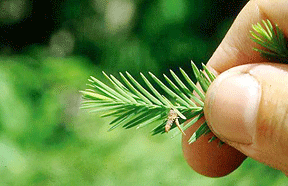
Volume XVII, Issue 28 # July 9 - July 15, 2009 |
 |
by Dr. Frank Gouin
The Early Bird Gets Rid of Bagworms
The bigger they grow, the harder they fall
June is the beginning of the bagworm season, but they might not be as bad this year as they have been because of the heavy downpours we have experienced. I have been shearing Christmas trees since the first week of June, and I have not as yet seen one bagworm. This is unusual since white pine trees seem to attract these pests, especially in Christmas tree orchards where there is a concentration of trees. In 2008, I recorded my first bagworm sighting on June 10.

![]() Look for young bagworms dangling from the ends of the new young needles. They will appear as a small funnel about one-eighth-inch long. You will see them move slowly if you stare at them for a minute or so.
Look for young bagworms dangling from the ends of the new young needles. They will appear as a small funnel about one-eighth-inch long. You will see them move slowly if you stare at them for a minute or so.
Since the eggs hatch over a period of several weeks, delay spraying until the bags grow to one-fourth or half an inch long. At this stage of growth they are easily controlled by spraying with Dipel or Thuracide. Both of these sprays are made from the Bt bacteria, which is highly effective in controlling not only bagworms but also tent caterpillars, gypsy moths and cabbage loopers, among other pests.
It is best to spray early in the morning when the insects are most susceptible. It is also important to remember that if your Bt is more than two years old, it is most likely no longer active. Thus it is best that you purchase only what you will need for one year so that you begin the season with a fresh supply.
Other ornamentals that are equally susceptible to bagworms are spruce, fir, junipers, arborvitae and red cedar.
If you delay controlling the bagworms until after the bags are an inch or longer, you will need to either hand pull the bags from the plants or use a hard pesticide such as Sevin to control them.
I’m a Believer
Q I believe you had some advice three to four months ago about cutting back those old butterfly bushes. My two bushes were 16 years old, large and breaking apart. I cut them down to ground level as you suggested. I then told my wife, “This will never work. That Bay Weekly guy is full of it. It will never grow back again.”
Well it did! With lots of vigorous shoots. On bended knee, I beg forgiveness and give thanks for the valuable information.
–Bill Barnes, Dunkirk
A The butterfly bush is one plant you can’t kill even if you cut it back with a chainsaw. It’s a survivor. Cut it back to the ground every year if you wish to contain its growth. The earlier you cut it back in the spring, the earlier it will flower and begin attracting butterflies.